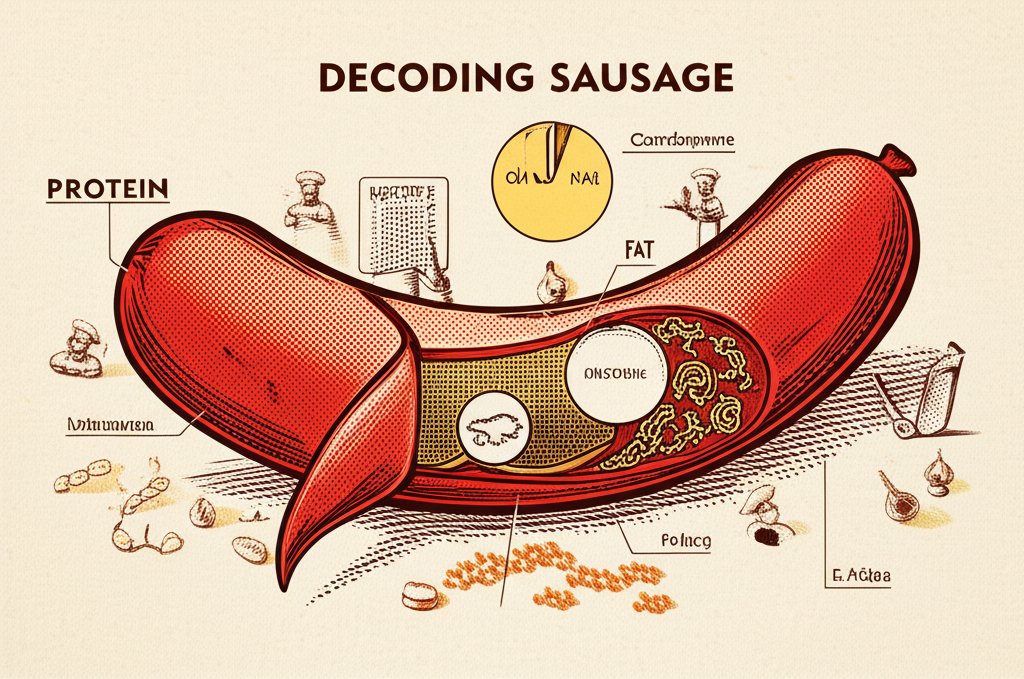Thinking about a quick breakfast? Sausage links might seem like an easy option, but before you fry them up, understanding their sausage links nutrition facts is key. Are you getting a protein boost, or a sodium bomb? Knowing what’s actually in your sausage can help you make smarter choices for your overall diet.
At a glance:
- Uncover the detailed nutritional breakdown of common sausage links.
- Compare different sausage types to pinpoint healthier options.
- Learn to navigate sodium, fat, and protein content for informed decisions.
- Discover practical ways to balance sausage with other nutritious foods.
- Address common concerns and questions about sausage in a balanced diet.
Decoding Sausage: A Nutritional Deep Dive
Sausage links, a breakfast staple for many, come in countless varieties. From pork to poultry, mild to spicy, the nutritional landscape varies wildly. Let’s break down what you typically find in a standard serving (around 2 links, or 75g) of generic pork sausage links.
- Calories: Approximately 200-250 calories.
- Fat: 15-20 grams, often a mix of saturated and unsaturated fats. Saturated fat content is a key area to watch.
- Protein: 7-10 grams, a decent protein source.
- Sodium: 500-700mg, a significant portion of your daily recommended intake.
- Carbohydrates: Typically low, around 1-3 grams.
Keep in mind that these are averages. The specific brand and ingredients used can dramatically shift these numbers. Always read the label!
Sausage Showdown: Comparing Types
Not all sausage is created equal. Here’s how common types stack up, primarily focusing on differences related to sausage links nutrition facts:
| Sausage Type | Key Differences | Potential Benefits | Potential Drawbacks |
|---|---|---|---|
| Pork Sausage | High in fat, often high in sodium. Classic flavor. | Readily available, generally affordable. | High saturated fat content, can contribute to elevated cholesterol. Often heavily processed. |
| Turkey Sausage | Lower in fat and calories compared to pork. | Leaner protein source, lower saturated fat. | Can be higher in sodium than some pork sausages to compensate for flavor. Texture can be less appealing to some. |
| Chicken Sausage | Similar to turkey sausage in terms of lower fat content. | Another lean option, often available in a wider variety of flavors. | Like turkey, sodium can be a concern. Sometimes contains added sugars. |
| Italian Sausage (Sweet) | Often made with pork, seasoned with fennel and other spices. Can be high in fat. | Flavorful, good source of protein. | Typically high in fat and sodium. Added sugars are common in sweeter varieties. |
| Vegetarian Sausage | Varies widely depending on ingredients (soy, vegetables, plant-based protein). | Can be lower in fat and cholesterol, good source of fiber depending on ingredients. | Protein content can vary. May contain highly processed ingredients or artificial additives. Nutrient profile depends entirely on the base ingredients used (e.g., pea protein isolate). |
| Example: A breakfast comparing pork and chicken sausage links revealed that the chicken sausage had 40% less fat and 25% fewer calories. However, its sodium content was slightly higher. |
Navigating the Nutritional Minefield: Key Considerations

Sausage can fit into a healthy diet, but moderation and smart choices are crucial. Here’s how to navigate the nutritional considerations:
- Sodium Overload: Sausage is often loaded with sodium, which can contribute to high blood pressure and water retention. Look for “low sodium” or “reduced sodium” varieties.
- Fat Content: Pay close attention to the total fat and saturated fat content. Opt for leaner options like turkey or chicken sausage.
- Ingredient List: Scrutinize the ingredient list. Avoid sausages with excessive fillers, artificial additives, or added sugars. A shorter ingredient list is generally better.
- Portion Control: Stick to a single serving (usually two links), and be mindful of what you’re pairing it with.
- Hidden Sugars: Some sausages, particularly flavored varieties, can contain added sugars. Be aware of this hidden source of empty calories.
When considering sausage links nutrition facts you also need to consider what you’re eating with your sausage. Are saltines good for you? Are saltines good for you? If you are looking for a low effort side that does not contain as much salt, saltines aren’t the best choice.
Building a Balanced Plate: Sausage Done Right
The key to enjoying sausage without derailing your health goals is to balance it with nutritious counterparts. Here are some tips:
- Pair with Fiber: Combine sausage with high-fiber foods like whole-grain toast, oatmeal, or a side of vegetables. Fiber helps promote satiety and regulate blood sugar levels.
- Add Protein: Sausage provides protein, but consider adding another source, such as eggs or Greek yogurt, to create a more complete and satisfying meal.
- Embrace Vegetables: Load up on vegetables! Include sautéed spinach, bell peppers, onions, or mushrooms alongside your sausage.
- Choose Healthy Fats: If your sausage is high in fat, balance it with healthy fats from sources like avocado or nuts.
Example: Instead of sausage and white toast, try turkey sausage with scrambled eggs, avocado slices, and a side of whole-grain toast. This creates a more balanced and nutritious breakfast.
Practical Playbook: Quick Tips for Sausage Success
- Read Labels Diligently: Don’t rely on marketing claims. Always scrutinize the nutrition facts label.
- Compare Brands: Don’t settle for the first sausage you see. Compare different brands to find healthier options.
- Make Your Own: Consider making your own sausage at home. This allows you to control the ingredients and sodium content.
- Pre-Cook and Portion: Pre-cook a batch of sausage links on the weekend and portion them out for quick and easy weekday breakfasts. This helps with portion control and prevents overeating.
- Grill or Bake, Don’t Fry: Opt for grilling or baking your sausage instead of frying it in oil. This reduces the fat content.
- Drain Off Excess Fat: After cooking, drain off any excess fat from the sausage.
- Spice It Up Naturally: Instead of relying on high-sodium seasonings, use herbs and spices like garlic powder, onion powder, paprika, or chili powder to enhance the flavor.
Quick Answers: Addressing Common Sausage Questions

- Is sausage a good source of protein? Yes, sausage provides a decent amount of protein, contributing to muscle building and satiety. However, consider the other nutritional factors like fat and sodium.
- Can I eat sausage if I’m trying to lose weight? Yes, but in moderation. Choose leaner options, control your portion sizes, and balance it with healthy foods.
- Are all vegetarian sausages healthy? Not necessarily. Some vegetarian sausages can be highly processed and contain artificial ingredients. Read the label carefully and choose options made with whole, recognizable ingredients.
- What’s the best way to cook sausage? Grilling, baking, or pan-frying with minimal oil are healthier options than deep-frying.
- Is it okay to eat sausage every day? Eating sausage every day isn’t recommended due to its high sodium and fat content. Enjoy it as an occasional treat rather than a daily staple.
- How can I reduce the sodium content of sausage? Look for “low sodium” or “reduced sodium” varieties. You can also rinse cooked sausage under water to remove some of the surface sodium, although this can affect the flavor.
Sausage Strategy: A Decision Tree
Here’s a quick guide to help you make informed sausage choices:
- Goal: Weight Loss, General Health, Muscle Building?
- Fat: High or Low? (Aim for Leaner Options)
- Sodium: High or Low? (Prioritize Reduced Sodium)
- Ingredients: Clean or Processed? (Choose Simpler Lists)
- Balance: How Will You Pair It? (Fiber, Protein, Veggies)
By considering these factors, you can navigate the world of sausage and make choices that align with your health goals.
Beyond the Basics: Sausage and Specific Diets
- Low-Carb Diets: Sausage can fit into low-carb diets due to its low carbohydrate content. However, be mindful of the fat content and choose leaner options.
- Gluten-Free Diets: Many sausage varieties are naturally gluten-free. However, always check the label to ensure that there are no gluten-containing fillers or additives.
- Vegetarian/Vegan Diets: There are numerous vegetarian and vegan sausage options available. Choose options made with whole, recognizable ingredients and that provide a good source of protein.
- Low-Sodium Diets: Opt for “low sodium” or “reduced sodium” sausage varieties. Be aware that even these options may still contain a significant amount of sodium, so portion control is crucial.
Your Sausage Action Plan
Understanding sausage links nutrition facts empowers you to make informed choices. Prioritize leaner options, watch your sodium intake, and build a balanced plate. By doing so, you can enjoy sausage without compromising your health goals. Small changes, like swapping pork for turkey sausage or adding a side of spinach, can make a big difference over time. Now, go forth and conquer the breakfast aisle with your newfound sausage savvy!
- Why Glass Boxes for Lunch Are Trending for Meal Prep - December 17, 2025
- Bento Box Glass Offers Practical, Eco-Friendly Meal Storage - December 16, 2025
- The Best Bento Box Price For Your Perfect Packed Lunch - December 15, 2025










